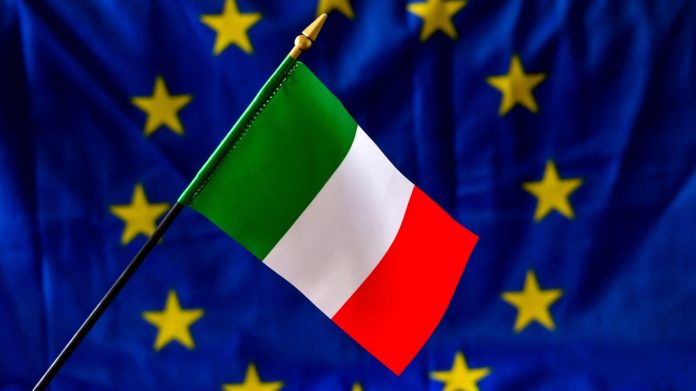Italian Prime Minister Giuseppe Conte submitted a smaller deficit forecast in the new budget proposal Tuesday in the hopes of appeasing the European Union, a move that sent benchmark Italian bond yields to their lowest levels since September.
That might suggest investors no longer see an all-out clash between Rome and Brussels in the horizon, staving off a major risk to global investors who have worried such a conflict could bring about the end of the eurozone.
Conte had submitted a deficit target of 2.04% of Italy’s gross domestic product, marking an about-face from their initial 2.4% deficit to GDP target rejected by the European Commission. The earlier proposal had aroused concerns that, if passed, the third largest economy in the eurozone was at risk of hurtling towards an unsustainable fiscal trajectory.
The 10-year Italian government bond yield
TMBMKIT-10Y, +0.00%
fell 4.2 basis points to 2.966%, after falling as low as 2.887% earlier in the day. The benchmark yield hasn’t finished below the 3% level since September. The rally helped narrow the all-important spread between it and the 10-year German bond yield
TMBMKDE-10Y, +0.00%
to 265 basis points, much slimmer than its five-year width of 325 basis points hit in November. Bond prices move in the opposite direction of yields.
A narrower spread indicates bond buyers are demanding less compensation for the relative risk of holding Italian debt over their risk-free German peers.
See: Italy stocks stand out in Europe, where ECB grabs the spotlight
Yet investors have long said the change to deficit target is cosmetic, if only because it ultimately reflects how the Italian economy fares. If Italian growth softens more than expected next year, even a more muted deficit target will still lack credibility. The GDP forecast in the initial fiscal plan assumed Italy would grow at a pace of 1.5% in 2019, even though the Organization of Economic Development expects it to slow to 0.9%.
“The main issue remains Italy’s ability to generate higher growth. Without that, it’s just a matter of time until this and other tensions resurface,” said Mohamed El-Erian, economic adviser to Allianz, in a tweet.
That’s perhaps why European Commissioner for Economic and Financial Affairs, Taxation and Customs Pierre Moscovici said only changing the deficit number without more substantial tweaks to their fiscal plan would not be enough, though he underlined his desire to pursue a deal with Rome.
And Italian politicians could still change their mind, said Ferdinando Giugliano, an economic columnist for Bloomberg Opinion.
He points out traders have yet to hear from deputy Prime Minister Matteo Salvini and deputy Prime Minister Luigi di Maio, the respective heads of the rightwing League and the antiestablishment 5 Star Movement making up the coalition government. Without their public approval, the sigh of relief from Italian bondholders could soon turn into groans.
When finance minister Giovanni Tria suggested a deficit target below 2% in September, di Maio and Salvini pushed back and ensured the first budget draft sent to Brussels contained more fiscal easing than investors had expected, paving the way for the current clash between Italy and the European Commission.
But the rally does not necessarily imply bondholders are satisfied with the recent steps undertaken by Rome. Rather, the recent yield drop indicates investors’ hopes that a full-blown clash between Italy and the European Union may be averted, said market participants.
“Although more tweaks seem necessary and an [excessive deficit procedure] may not be avoided, in any case financial sanctions, if any, won’t be forthcoming before the second half of 2019,” said Martin Van Vliet, senior rates strategist for ING Financial Markets, in an e-mail, referring to the European Commission’s process for investigating and punishing member states that have breached the EU’s fiscal rules.
It helps that France is now at risk of breaching the EU’s own fiscal rules after French President Emmanuel Macron promised a whole slew of measures that would loosen Paris’s purse strings this week, said Van Vliet. To punish Italy while giving France a break would send the wrong message and draw claims of uneven treatment.
Read: Will EU treat Italy more leniently as France’s Macron risks breaching fiscal rules?
The recent buying of Italian government paper also reflects how many bearish investors were caught offside by Rome’s willingness to reach a deal, even if that shift in perception originated from Rome’s decision to cut its deficit target to a level that still strikes economists as unrealistic. Traders rushed to close their short positions to avoid running into further losses from a rise in Italian government debt prices, juicing the rally.
“Everyone I spoke to in recent months thought that spreads would widen further,” said Van Vliet.
IHS Markit reported that the total amount of Italian government bonds borrowed for the purpose of shorting the debt stood at around $30 billion in October, around its highest levels since May 2017.
Providing critical information for the U.S. trading day. Subscribe to MarketWatch’s free Need to Know newsletter. Sign up here.
Source : MTV













